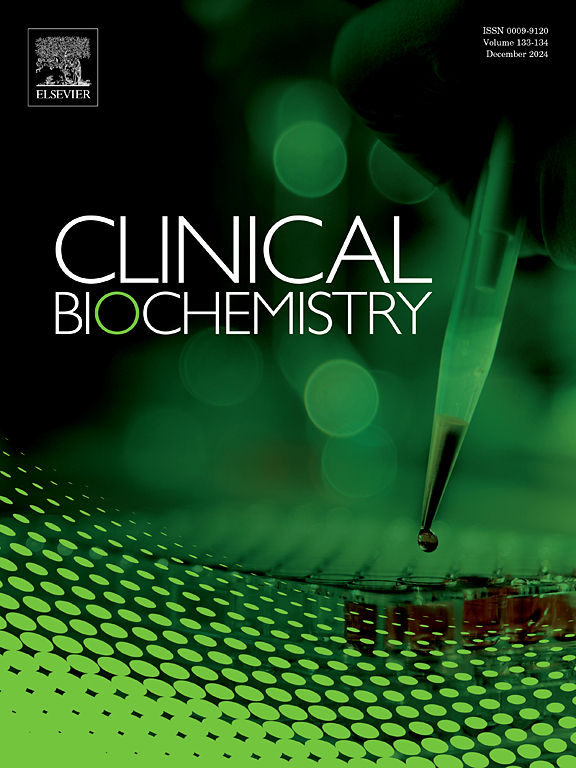肿瘤相关抗原与原发性斯约格伦综合征相关的间质性肺病和疾病活动有关
IF 2.1
3区 医学
Q2 MEDICAL LABORATORY TECHNOLOGY
引用次数: 0
摘要
目的肿瘤相关抗原(TAAs)已被证实与多种结缔组织疾病相关。然而,TAAs在原发性Sjögren综合征(pSS)患者中的作用尚不清楚。本研究旨在探讨TAA水平与pSS患者全身临床表现及疾病活动度的相关性。方法回顾性收集pSS患者108例(pSS组)和健康者100例(hc组)的资料。taa阳性组与taa阴性组临床特征及血清学指标比较。采用单因素和多因素回归分析TAAs阳性的独立危险因素,采用受试者工作特征曲线分析TAAs对pss相关性间质性肺疾病(pSS-ILD)的诊断效果。结果pSS组CEA、CA125、CA15-3、CYFRA21-1阳性率高于对照组,血清CA125、CA15-3、CYFRA21-1水平高于对照组。taa阳性组ILD、胸腔积液、心包积液、ESSDAI≥5的发生率高于taa阳性组。多因素logistic回归分析显示,ILD的发生率是TAA阳性的独立危险因素。CEA、CYFRA21-1、NSE诊断pSS-ILD的AUC分别为0.690、0.840、0.872,联合诊断可达0.952。结论pSS患者taa阳性率及血清水平明显升高。taa阳性组与ESSDAI评分相关。TAA阳性是ILD的独立危险因素,CYFRA21-1和NSE对pSS-ILD患者的诊断价值最高。本文章由计算机程序翻译,如有差异,请以英文原文为准。
Tumor-associated antigens are associated with primary Sjögren’s syndrome-related interstitial lung disease and disease activity
Objectives
Tumor-associated antigens (TAAs) have been shown to be associated with a variety of connective tissue diseases. However, the role of TAAs in primary Sjögren’s syndrome (pSS) patients is still unclear. This study aims to explore the correlation between TAA levels and systemic clinical manifestations and disease activity in pSS patients.
Methods
Data were retrospectively collected from 108 patients with pSS (pSS group) and 100 healthy subjects (HCs group). Comparison of clinical characteristics and serological parameters between the TAA-positive group and the TAA-negative group. The independent risk factors of TAAs positivity were analyzed by univariate and multivariate regression, and the receiver operating characteristic curve was used to analyze the diagnostic performance of TAAs for pSS-associated interstitial lung disease (pSS-ILD).
Results
Compared with the control group, the positivity rates of CEA, CA125, CA15-3, and CYFRA21-1 were higher, and the levels of serum CA125, CA15-3, and CYFRA21-1were higher in the pSS group. The incidence of ILD, pleural effusion, pericardial effusion, and ESSDAI ≥5 in the TAA-positive group was higher than in the TAA-positive group. Multivariate logistic regression analysis showed that the incidence of ILD was identified as an independent risk factor for TAA positivity. The AUC of CEA, CYFRA21-1, and NSE in the diagnosis of pSS-ILD were 0.690, 0.840, and 0.872, respectively, and the combined diagnosis could reach 0.952.
Conclusion
Certain TAA-positive rates and serum levels were increased in pSS patients. The TAA-positive group is correlated with the ESSDAI scores. ILD was an independent risk factor for TAA positivity, and CYFRA21-1 and NSE had the best diagnostic value in patients with pSS-ILD.
求助全文
通过发布文献求助,成功后即可免费获取论文全文。
去求助
来源期刊

Clinical biochemistry
医学-医学实验技术
CiteScore
5.10
自引率
0.00%
发文量
151
审稿时长
25 days
期刊介绍:
Clinical Biochemistry publishes articles relating to clinical chemistry, molecular biology and genetics, therapeutic drug monitoring and toxicology, laboratory immunology and laboratory medicine in general, with the focus on analytical and clinical investigation of laboratory tests in humans used for diagnosis, prognosis, treatment and therapy, and monitoring of disease.
 求助内容:
求助内容: 应助结果提醒方式:
应助结果提醒方式:


